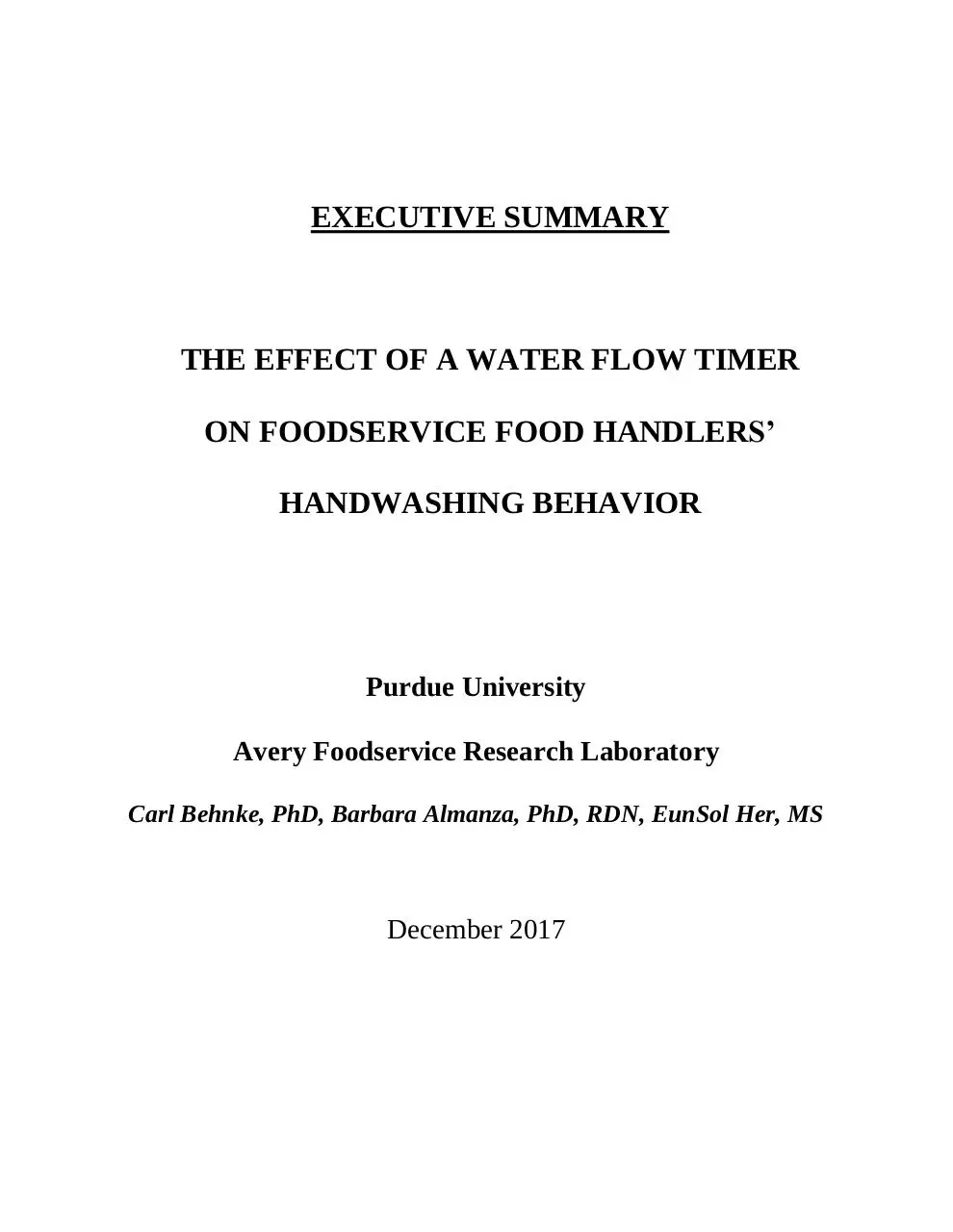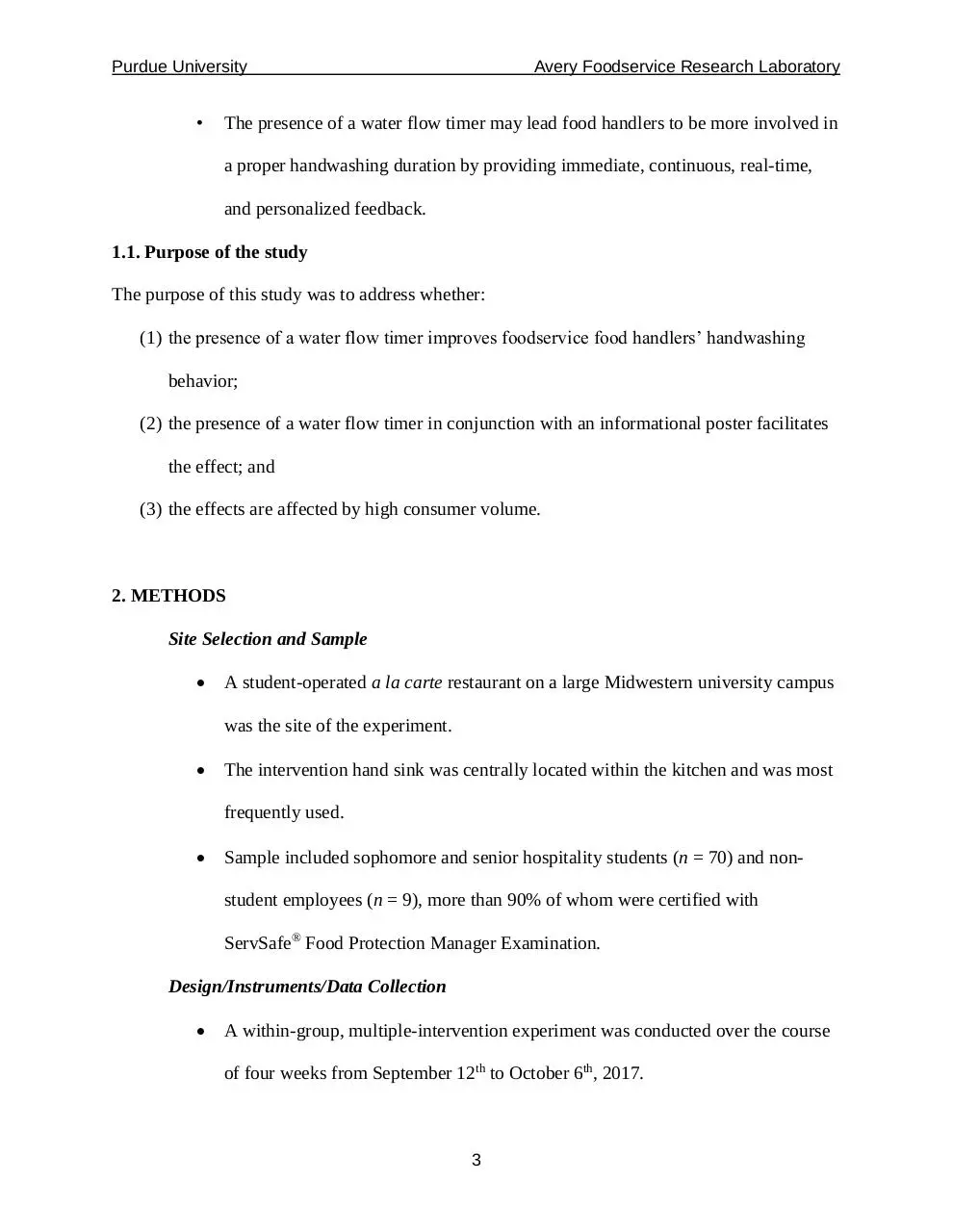Purdue Study Executive Summary SaniTimer (PDF)
File information
Title: Submission Guidelines
Author: Thomas Schrier
This PDF 1.5 document has been generated by Microsoft® Word 2013, and has been sent on pdf-archive.com on 25/01/2018 at 18:32, from IP address 47.185.x.x.
The current document download page has been viewed 838 times.
File size: 584.82 KB (8 pages).
Privacy: public file





File preview
EXECUTIVE SUMMARY
THE EFFECT OF A WATER FLOW TIMER
ON FOODSERVICE FOOD HANDLERS’
HANDWASHING BEHAVIOR
Purdue University
Avery Foodservice Research Laboratory
Carl Behnke, PhD, Barbara Almanza, PhD, RDN, EunSol Her, MS
December 2017
Purdue University
Avery Foodservice Research Laboratory
1. INTRODUCTION
Importance of proper handwashing
•
Poor personal hygiene is one of five risk factors contributing to foodborne illness
in foodservice and retail food stores, and thus proper handwashing is critical
(FDA, 2010, 2017; Green et al., 2006, 2007).
•
However, compliance with proper handwashing is still problematic (e.g., only
24% in full service restaurants; FDA, 2010).
Passive/indirect intervention strategies for behavioral change
•
Mounting evidence suggests that classical education strategies of knowledge
transfer are not sufficient to drive behavioral change (Evans & McCormack,
2008; Schroeder et al., 2016).
•
Instead, active/direct interventions involving motivational or behavior-based
training (Pellegrino, Crandall, O'Bryan, & Seo, 2015; Yu, Neal, Dawson, &
Madera, 2017) are gaining interest and found effective in improving hand hygiene
practices.
•
In comparison, passive/indirect interventions with only a subtle change in the
environment or system (FDA, 2010; Green et al., 2007; Pellegrino et al., 2015;
Viator, Blitstein, Brophy, & Fraser, 2015) may also help behavioral changes with
less time/cost commitment and fewer financial obligations for restaurant
operations.
Water flow timer
•
Sufficient duration (≥ 20 sec; ServSafe®) is an important component in proper
handwashing to reduce the number of microorganisms on hands (CDC, 2015).
2
Purdue University
•
Avery Foodservice Research Laboratory
The presence of a water flow timer may lead food handlers to be more involved in
a proper handwashing duration by providing immediate, continuous, real-time,
and personalized feedback.
1.1. Purpose of the study
The purpose of this study was to address whether:
(1) the presence of a water flow timer improves foodservice food handlers’ handwashing
behavior;
(2) the presence of a water flow timer in conjunction with an informational poster facilitates
the effect; and
(3) the effects are affected by high consumer volume.
2. METHODS
Site Selection and Sample
A student-operated a la carte restaurant on a large Midwestern university campus
was the site of the experiment.
The intervention hand sink was centrally located within the kitchen and was most
frequently used.
Sample included sophomore and senior hospitality students (n = 70) and nonstudent employees (n = 9), more than 90% of whom were certified with
ServSafe® Food Protection Manager Examination.
Design/Instruments/Data Collection
A within-group, multiple-intervention experiment was conducted over the course
of four weeks from September 12th to October 6th, 2017.
3
Purdue University
Avery Foodservice Research Laboratory
Multiple-intervention included:
-
Week 1) baseline phase;
-
Week 2) a single intervention phase using a water flow timer
(SaniTimer®);
-
Week 3) multiple intervention phase using the water flow timer and an
informational poster (developed based on ServSafe®); and
Week 4) withdrawal phase.
The water flow timer was attached to a faucet and had a digital display face
approximately 2" in diameter, which enabled food handlers to observe a thirty
second countdown on a display that begins when the water starts flowing and
continues until thirty seconds have passed.
The informational poster highlighted proper five-step handwashing procedures
and the minimum duration of scrubbing with soap as well as total five steps.
Data were collected from Tuesday to Friday, 7:30am to 2:30pm, using a small
motion-detecting video camera (AUKEY DR-01 Dash Cam) that included a date
and time stamp for recordings.
The motion-detecting video camera was installed on the top of a sink with the lens
directed at the faucet only, thereby capturing handwashing instances without
person-identifiable information.
Behavioral measures
Quantitative
-
Frequency of handwashing instances
-
Overall duration of handwashing instances
4
Purdue University
Avery Foodservice Research Laboratory
Qualitative
-
Compliance to proper scrubbing duration (≥ 10 sec or not)
-
Compliance to proper five-step handwashing sequence (wetting, soaping,
scrubbing, washing, and drying)
-
Compliance to complete proper handwashing (meeting both proper
scrubbing duration and five-step handwashing sequence or not)
3. RESULTS
A total of 839 handwashing instances were observed over 112 hours (see Table 1
for detailed frequencies and descriptive statistics of all measures).
The analysis of variance (ANOVA) results showed that frequency of
handwashing instances did not significantly vary across the weeks (p = .43).
The ANOVA results showed that, despite the highest consumer traffic, duration
of handwashing instances significantly increased in week 2 over week 1 (14.9 sec
vs. 11.6 sec; p = .002) and significantly dropped in week 4 in comparison to week
3 (12.8 sec vs. 15.7 sec; p = .02).
Although not definitive, the logistic regression results suggested that the
compliance rates for proper scrubbing duration (p = .095) and complete proper
handwashing varied across the weeks (p = .071; i.e., higher percentages in week 2
and week 3 than in week 1 and week 4), and that the compliance rate for
following the proper five-step sequence increased in week 2 over week 1 (49.1%
vs. 40.7%; p = .076) despite the high consumer volumes in week 2 and week 3.
5
Purdue University
Avery Foodservice Research Laboratory
Point-biserial correlation results showed that increased handwashing duration was
positively associated with proper scrubbing duration (rpb = .51, p < .001), proper
sequence (rpb = .41, p < .001), and complete proper handwashing (rpb = .45, p <
.001).
Table 1. Handwashing behavioral measures and consumer volume
Proper
Complete
scrubbing
Proper
proper
Consumer
Week Frequencyns. Duration*** duration† sequencens. handwashing†
volume
1
204
11.6
8.3%
40.7%
6.4%
152
2
234
14.9
12.0%
49.1%
10.7%
244
3
186
15.7
11.3%
39.8%
8.1%
187
4
215
12.8
5.6%
46.0%
4.2%
158
Notes. Week 1. Baseline; Week 2. Timer; Week 3. Timer + Poster; Week 4. Withdrawal.
Duration is in seconds.
Complete proper handwashing indicates compliance to both proper sequence and scrubbing.
In the consumer volume, one day of the week 2 included special banquet for 100 consumers,
greater than an average daily volume.
Superscripts indicate the significance testing across four weeks.
***
p < .001. †p < .1. nsp ≥ .1.
4. CONCLUSION
•
This study provided reliable and quantifiable data about food handlers’
handwashing practices.
•
Findings provided useful information about whether passive/indirect intervention
strategies in handwashing practices such as the mere presence of a water flow
timer are effective in driving behavioral changes of food handlers.
•
If coupled with an active/direct training for providing the rationale, the effect of
the passive/indirect intervention in its constant reinforcement may become even
stronger.
6
Purdue University
Avery Foodservice Research Laboratory
NOTES
1. This report is an executive summary of a manuscript in preparation for journal
submission.
2. The authors acknowledge the support provided by SaniTimer®.
7
Purdue University
Avery Foodservice Research Laboratory
References
Centers for Disease Control and Prevention. (2015). Handwashing: Clean hands save lives.
Show me the science—How to wash your hands. Retrieved from
https://www.cdc.gov/handwashing/show-me-the-science-handwashing.html
Evans, W. D., & McCormack, L. (2008). Applying social marketing in health care:
Communicating evidence to change consumer behavior. Medical Decision Making,
28(5), 781-792.
Food and Drug Administration. (2010). FDA trend analysis report on the occurrence of
foodborne illness risk factors in selected institutional foodservice, restaurant, and retail
food store facility types (1998-2008). Retrieved from https://wayback.archiveit.org/7993/20170113095247/http://www.fda.gov/downloads/Food/GuidanceRegulation/
RetailFoodProtection/FoodborneIllnessRiskFactorReduction/UCM369245.pdf
Food and Drug Administration. (2017). Retail food protection: Employee health and personal
hygiene handbook. Retrieved from
https://www.fda.gov/food/guidanceregulation/retailfoodprotection/industryandregulatory
assistanceandtrainingresources/ucm113827.htm
Green, L. R., Radke, V., Mason, R., Bushnell, L., Reimann, D. W., Mack, J. C., ... & Selman, C.
A. (2007). Factors related to food worker hand hygiene practices. Journal of Food
Protection, 70(3), 661-666.
Green, L. R., Selman, C. A., Radke, V., Ripley, D., Mack, J. C., Reimann, D. W., … & Bushnell,
L. (2006). Food worker hand washing practices: An observational study. Journal of Food
Protection, 69(10), 2417-2423.
Pellegrino, R., Crandall, P. G., O'Bryan, C. A., & Seo, H. S. (2015). A review of motivational
models for improving hand hygiene among an increasingly diverse food service
workforce. Food Control, 50, 446-456.
Schroeder, M., Yang, L., Eifert, J., Boyer, R., Chase, M., & Nieto-Montenegro, S. (2016).
Evaluation of how different signs affect poultry processing employees' hand washing
practices. Food Control, 68, 1-6.
Viator, C., Blitstein, J., Brophy, J. E., & Fraser, A. (2015). Preventing and controlling foodborne
disease in commercial and institutional food service settings: A systematic review of
published intervention studies. Journal of Food Protection, 78(2), 446-456.
Yu, H., Neal, J., Dawson, M., & Madera, J. M. (2017). Implementation of behavior-based
training can improve food service employees’ handwashing frequencies, duration, and
effectiveness. Cornell Hospitality Quarterly (in press). doi: 10.1177/1938965517704370
8
Download Purdue Study Executive Summary - SaniTimer
Purdue Study Executive Summary - SaniTimer.pdf (PDF, 584.82 KB)
Download PDF
Share this file on social networks
Link to this page
Permanent link
Use the permanent link to the download page to share your document on Facebook, Twitter, LinkedIn, or directly with a contact by e-Mail, Messenger, Whatsapp, Line..
Short link
Use the short link to share your document on Twitter or by text message (SMS)
HTML Code
Copy the following HTML code to share your document on a Website or Blog
QR Code to this page

This file has been shared publicly by a user of PDF Archive.
Document ID: 0000726419.